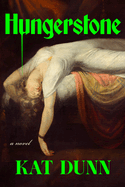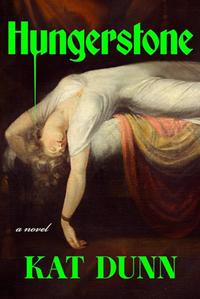
 British fantasy novelist Kat Dunn crafts a sensuous, bloodthirsty delight in Hungerstone, a twist on the classic vampire tale Carmilla, set during the Industrial Revolution.
British fantasy novelist Kat Dunn crafts a sensuous, bloodthirsty delight in Hungerstone, a twist on the classic vampire tale Carmilla, set during the Industrial Revolution.
Lenore works hard at being a good wife to the handsome and wealthy steel tycoon Henry. This includes staying collected and well-kept, managing her emotions, always knowing exactly what to say, and never asking too many questions, even as he becomes increasingly cold and secretive toward her. But Lenore knows she's lucky; marrying Henry got her and her family out of a precarious financial situation and he has the dashing appearance of a young husband any woman would envy.
But on the way from London to their countryside estate for a hunting party, a carriage accident throws the enigmatic and alluring Carmilla into their paths. At first, Carmilla appears to be a pale, weak, helpless young woman, of high birth but no discernable origin. As Lenore's household nurses Carmilla back to health, however, Lenore comes to recognize the woman as so much more: a vital, manipulative, seductive creature who might see Lenore's life more clearly than Lenore herself does. As Carmilla awakens a new rage and new hunger inside Lenore, local girls begin dying. And soon, Lenore, too, begins developing a taste for blood.
Dunn excels at capturing the classic gothic atmosphere of her setting. The narrative luxuriates in period-specific details like "paper soft with wear," "hoofs striking flagstones and splintering wood," and "the ceiling... buckled with damp after the storm." Through thick drapes and misty moorlands, Lenore's first-person voice, which starts strained with care and reserve, becomes increasingly untethered. While Carmilla has her own appeal, it is Lenore and her unraveling internal monologue that really seduce readers. Her raw desire and ferocity that ultimately burst through feel more like a relief than a sign of devastation.
Dunn isn't shy, either, about digging into the dual gore and heated sexuality underlying Lenore's world. While this pulsing presence ultimately does surface in explosive ways, it is present in glimpses even from the start, like when Lenore watches Carmella "tearing off delicate strips of lamb and eating with flashing teeth... the watery blood from the meat pooling on her plate." Although this "delicate" violence holds the promise of something as intoxicating as it is vicious, the other places violence lurks are less appealing. After an accident at Henry's factory, for example, one worker is left with a piece of machinery "wedged under his cheekbone, and his tongue laps at the blood filling his throat." In this truly disturbing, rather than deliciously macabre, rendering of violence, it becomes clear that Henry's world of industry and capitalist ambition is the true horror story, a nightmare of "blood and metal merging." --Alice Martin, freelance writer and editor
Shelf Talker: Kat Dunn's Hungerstone is an atmospheric, blood-drenched, feminist twist on classic vampire tropes, a sapphic delight and industrial horror story.

